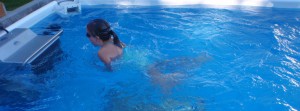Dr. Ken Swaim is one of my husband’s fishing buddies. He is also a life long swimmer, having been involved with his high school swim team, then swimming for exercise in the years since then. I used to see him all the time at the local indoor gym pool, but he says he stopped going because of the chemicals. He had not been swimming much for a couple of years. (click on any photo to enlarge)

Ever since he heard about my pool, he has said he wanted to come swim in it. I’m not sure what took him so long, but last week he called and asked if he and his lovely daughter, Abbey, could come try it. It was a warm summer evening and no one else was using it at the moment. They were here in about 10 minutes.
We talked briefly about it’s operation and how it is a little different swimming in the current. I pointed out how the mirror on the bottom is quite useful. He plunged in at a much higher speed than any other person has tried on their introductory swim! My husband took the controls and turned the water flow rate up faster. Ken kept swimming for about a minute.
Everyone so far comes up laughing when they first try the pool. Ken added exclamations of, “This is great!” He commented that within a few minutes, dealing with the flow and using the mirror, he learned all kinds of things about his stroke. I mentioned how pressing with his chest, plus smaller, faster kicks might help him keep his feet up, since they were obviously going sideways and sinking some. He tried again and looked more comfortable.
Now it was Abbey’s turn. She wanted the current turned way down, but mostly because she is so small it just sent her to the back of the pool. She began with a beautiful breast stroke, not having any trouble keeping up. After a bit, she switched to the crawl stroke, then the back stroke. Then, she accidentally caught the return current going back the other way and was whisked forward. She popped up, happy with her efforts, and not too disappointed to hear she had “cheated.”

The Swaim team had brought their own stop watch. Next, they set up a routine of alternating 1 -2 minute intervals. One of them held the watch and controlled the water flow, while the other swam. If the swimmer was gaining or losing too much compared to the current, the rate was adjusted. If the swimmer stopped too soon, the timer yelled, “____ more seconds!” Usually, it was Abbey telling her dad that he needed to swim longer, but then he was the one doing the 2 minute intervals. Abbey had to position herself way up in a front corner to avoid being whacked by her father’s rotating arms, but she was dedicated to her job.


When Ken tried the butterfly stroke, Abbey had to turn the flow rate even higher. He splashed so much water out of the pool that I need to add some soon! They were having a lot of fun with the physics of it all. For the finale, they each had a turn swimming against it at full speed. Ken was able to make it the length of the pool (or basically 13 feet up to the machine) in about 4 strokes. Without the current, it would have been less than one. Abbey could not quite make it, but at least she wasn’t held pinned against the back of the pool!

When they were done, we talked a little about what can be learned from swimming continuously versus in interval spurts. It seems like setting the Fastlane to a flow rate that can be maintained helps work on balance and form more, especially if one is not used to swimming in the current. But it could be fun to try the interval method someday with someone.
I think they might be back sometime, hopefully bringing Abbey’s mom along, too. I love to see people enjoy the pool, and I learn things from watching others experiment with it and describe their experience. The current may be challenging at first, but it is fun. Being outdoors to swim is unbeatable. Having friends to share it with is fantastic.
